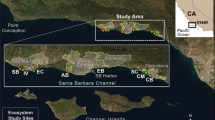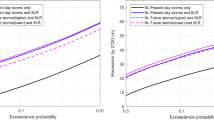Abstract
Sea-level rise (SLR) poses a range of threats to natural and built environments1,2, making assessments of SLR-induced hazards essential for informed decision making3. We develop a probabilistic model that evaluates the likelihood that an area will inundate (flood) or dynamically respond (adapt) to SLR. The broad-area applicability of the approach is demonstrated by producing 30 × 30 m resolution predictions for more than 38,000 km2 of diverse coastal landscape in the northeastern United States. Probabilistic SLR projections, coastal elevation and vertical land movement are used to estimate likely future inundation levels. Then, conditioned on future inundation levels and the current land-cover type, we evaluate the likelihood of dynamic response versus inundation. We find that nearly 70% of this coastal landscape has some capacity to respond dynamically to SLR, and we show that inundation models over-predict land likely to submerge. This approach is well suited to guiding coastal resource management decisions that weigh future SLR impacts and uncertainty against ecological targets and economic constraints.
This is a preview of subscription content, access via your institution
Access options
Subscribe to this journal
Receive 12 print issues and online access
$209.00 per year
only $17.42 per issue
Buy this article
- Purchase on Springer Link
- Instant access to full article PDF
Prices may be subject to local taxes which are calculated during checkout




Similar content being viewed by others
References
Horton, R. et al. in Climate Change Impacts in the United States: The Third National Climate Assessment (eds Melillo, J. M., Richmond, T. C. & Yohe, G. W.) 371–395 (US Global Change Research Program, 2014).
Wong, P. P. et al. in Climate Change 2013: The Physical Science Basis (eds Stocker, T. F. et al.) 361–409 (Cambridge Univ. Press, 2014).
Strauss, B. H., Ziemlinski, R., Weiss, J. L. & Overpeck, J. T. Tidally adjusted estimates of topographic vulnerability to sea level rise and flooding for the contiguous US. Environ. Res. Lett. 7, 014033 (2012).
Church, J. A. et al. in Climate Change 2013: The Physical Science Basis (eds Stocker, T. F. et al.) 1137–1216 (Cambridge Univ. Press, 2014).
Sweet, W. V. & Park, J. From the extreme to the mean: Acceleration and tipping points of coastal inundation from sea level rise. Earth’s Future 2, 579–600 (2014).
Gieder, K. D. et al. A Bayesian network approach to predicting nest presence of the federally-threatened piping plover (Charadrius melodus) using barrier island features. Ecol. Modelling 276, 38–50 (2014).
Peterson, G. D., Cumming, G. S. & Carpenter, S. R. Scenario planning: a tool for conservation in an uncertain world. Conserv. Biol. 17, 358–366 (2003).
Gesch, D. B. Analysis of Lidar elevation data for improved identification and delineation of lands vulnerable to sea-level rise. J. Coast. Res. 53, 49–58 (2009).
Parris, A. P. et al. Global Sea Level Rise Scenarios for the US National Climate Assessment (NOAA Tech Memo OAR CPO-1, 2012).
Kirwan, M. L. et al. Limits on the adaptability of coastal marshes to rising sea-level. Geophys. Res. Lett. 37, L23401 (2010).
Cowell, P. J., Roy, P. S. & Jones, R. A. Simulation of large-scale coastal change using a morphological behavior model. Mar. Geol. 126, 45–61 (1995).
Ranasinghe, R., Callaghan, D. & Stive, M. Estimating coastal recession due to sea level rise: beyond the Bruun Rule. Climatic Change 110, 561–574 (2012).
Wainwright, D. J. et al. Moving from deterministic towards probabilistic coastal hazard and risk assessment: development of a modelling framework and application to Narrabeen Beach, New South Wales, Australia. Coast. Eng. 96, 92–99 (2015).
National Research Council Science and Decisions: Advancing Risk Assessment (The National Academies, 2009).
Kopp, R. E. et al. Probabilistic 21st and 22nd century sea-level projections at a global network of tide-gauge sites. Earth’s Future 2, 383–406 (2014).
Marcy, D. et al. in Proc. 2011 Solutions Coast. Disast. Conf. (eds Wallendorv, L., Jones, C., Ewing, L. & Battalio, R.) 474–490 (American Society of Civil Engineers, 2011).
Cahoon, D. R. et al. in Coastal Sensitivity to Sea-Level Rise: A Focus on the Mid-Atlantic Region. A report by the US Climate Change Science Program and the Subcommittee on Global Change Research (ed. Titus, J. G.) 57–72 (US Environmental Protection Agency, 2009).
Clark, J. S. Coastal forest tree populations in a changing environment, Southeastern Long Island, New York. Ecol. Monogr. 56, 259–277 (1986).
Gutierrez, B. T., Williams, S. J. & Thieler, E. R. in Coastal Sensitivity to Sea-Level Rise: A Focus on the Mid-Atlantic Region. A report by the US Climate Change Science Program and the Subcommittee on Global Change Research (ed. Titus, J. G.) 43–56 (US Environmental Protection Agency, 2009).
Bamber, J. L. & Aspinall, W. P. An expert judgment assessment of future sea-level rise from the ice sheets. Nature Clim. Change 3, 424–427 (2013).
Horton, B. P., Rahmstorf, S., Engelhart, S. E. & Kemp, A. C. Expert assessment of sea-level rise by AD 2100 and AD 2300. Quat. Sci. Rev. 84, 1–6 (2014).
Lentz, E. E. et al. Evaluating the Coastal Landscape Response to Sea-Level Rise for the Northeastern US: Approach and Methods Open-File Report 2014-1252 (US Geological Survey, 2015).
Mastrandrea, M. D. et al. Guidance Note for Lead Authors of the IPCC Fifth Assessment Report on Consistent Treatment of Uncertainties (IPCC, 2010).
Alley, R. B. et al. Oceanic forcing of ice-sheet retreat: west Antarctica and more. Annu. Rev. Earth Planet. Sci. 43, 207–231 (2015).
Knutson, T. R. et al. Tropical cyclones and climate change. Nature Geosci. 3, 157–163 (2010).
Plant, N. G. & Stockdon, H. F. Probabilistic prediction of barrier-island response to hurricanes. J. Geophys. Res. 117, F03015 (2012).
Gutierrez, B. T., Plant, N. G. & Thieler, E. R. A Bayesian network to predict the coastal vulnerability to sea-level rise. J. Geophys. Res. 116, F02009 (2011).
Moss, R. H. et al. The next generation of scenarios for climate change research and assessment. Nature 463, 747–756 (2010).
Horton, R. et al. New York City Panel on Climate Change 2015 Report Chapter 2: Sea Level Rise and Coastal Storms. Ann. NY Acad. Sci. 1336, 36–44 (2015).
Taylor, K. E., Stouffer, R. J. & Meehl, G. A. An overview of CMIP5 and the experiment design. Bull. Am. Meteorol. Soc. 93, 485–498 (2012).
Marzeion, B., Jarosch, A. H. & Hofer, M. Past and future sea-level change from the surface mass balance of glaciers. Cryosphere 6, 1295–1322 (2012).
Radić, V. et al. Regional and global projections of twenty-first century glacier mass changes in response to climate scenarios from global climate models. Clim. Dynam. 42, 37–58 (2013).
Sella, G. F. et al. Observation of glacial isostatic adjustment in ‘stable’ North America with GPS. Geophys. Res. Lett. 34, L02306 (2007).
Zervas, C., Gill, S. & Sweet, W. Estimating Vertical Land Motion from Long-Term Tide Gauge Records Technical Report NOS CO-OPS 065 (US National Oceanographic and Atmospheric Administration, 2013).
Gesch, D. B. in Digital Elevation Model Technologies and Applications: The DEM User’s Manual 2nd edn (ed. Maune, D.) 99–118 (American Society for Photogrammetry and Remote Sensing, 2007).
Acknowledgements
This research was funded by the US Geological Survey Coastal and Marine Geology Program, the Department of the Interior Northeast Climate Science Center, and the US Army Corps of Engineers Institute for Water Resources under the Responses to Climate Change Program. We thank B. Strauss at Climate Central’s Surging Seas project for permission to use their base map in Fig. 2, and C. Ruppel and M. Gonneea for early reviews and discussion of this manuscript. Any use of trade, firm, or product names is for descriptive purposes only and does not imply endorsement by the US Government.
Author information
Authors and Affiliations
Contributions
E.R.T. and N.G.P. developed the concept; E.E.L., N.G.P. and E.R.T. conceptualized and designed the model; N.G.P. built the model; E.E.L. and S.R.S. performed the model runs; E.E.L. assessed and analysed the data; R.M.H. contributed the SLR projections; D.B.J. contributed regional elevation data; E.E.L., E.R.T. and N.G.P. co-wrote the paper with input from all co-authors.
Corresponding author
Ethics declarations
Competing interests
The authors declare no competing financial interests.
Supplementary information
Supplementary Information
Supplementary Information (PDF 5526 kb)
Rights and permissions
About this article
Cite this article
Lentz, E., Thieler, E., Plant, N. et al. Evaluation of dynamic coastal response to sea-level rise modifies inundation likelihood. Nature Clim Change 6, 696–700 (2016). https://doi.org/10.1038/nclimate2957
Received:
Accepted:
Published:
Issue Date:
DOI: https://doi.org/10.1038/nclimate2957
This article is cited by
-
An observation study of the combined river discharge and sea level impact on the duration of saltwater intrusion in Pearl River estuary–Modaomen waterway
Natural Hazards (2024)
-
Demonstrating the value of beaches for adaptation to future coastal flood risk
Nature Communications (2023)
-
Observation of the Coastal Areas, Estuaries and Deltas from Space
Surveys in Geophysics (2023)
-
Probabilistic patterns of inundation and biogeomorphic changes due to sea-level rise along the northeastern U.S. Atlantic coast
Landscape Ecology (2021)
-
A Review of Satellite Remote Sensing Techniques of River Delta Morphology Change
Remote Sensing in Earth Systems Sciences (2021)



